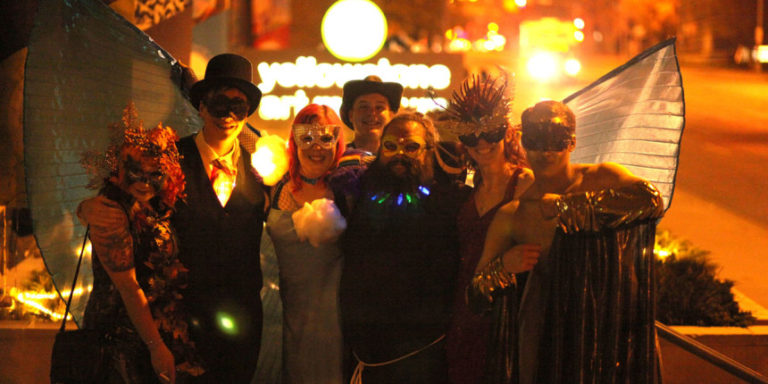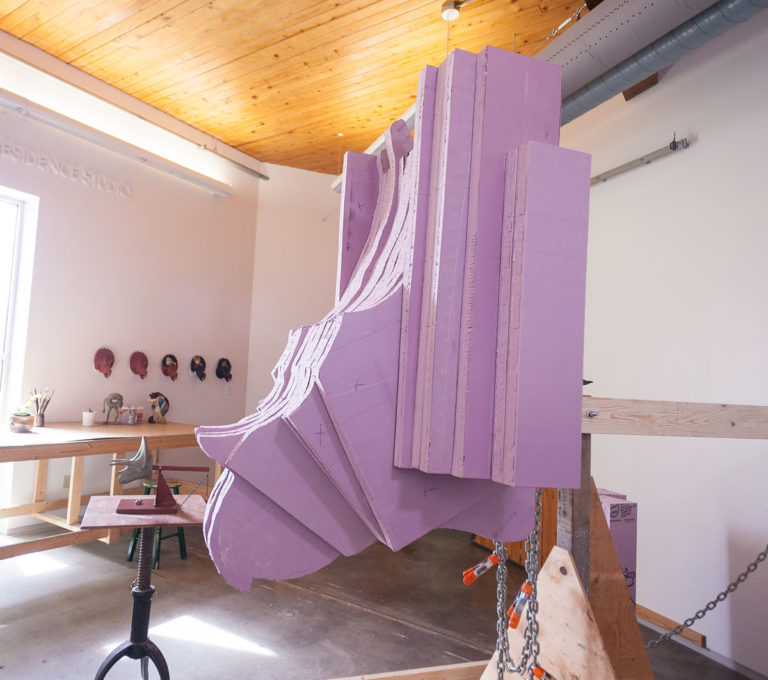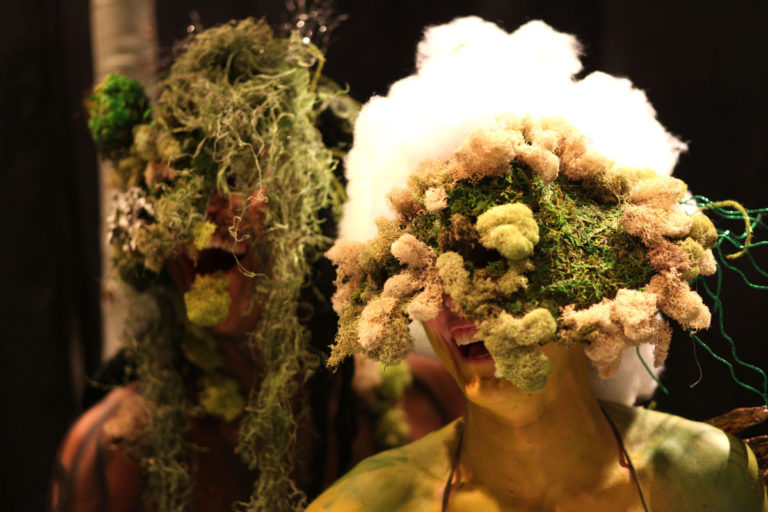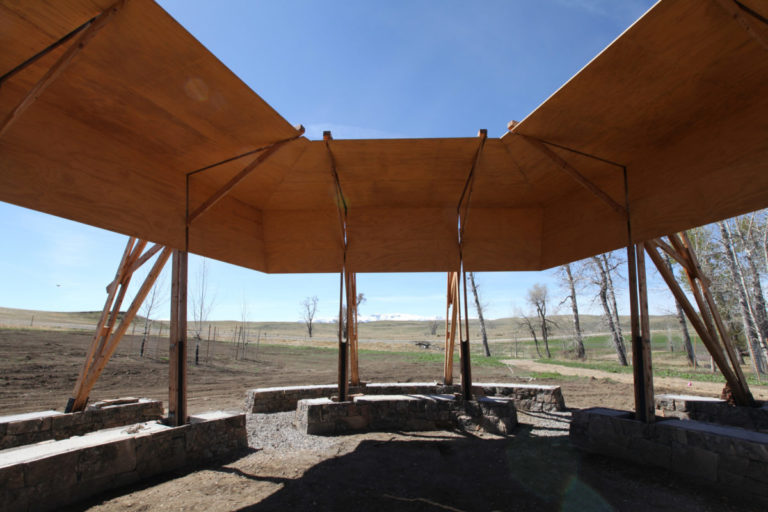Last One There
Billings, Montana isn’t known for its pretty face. The city sways in a cradle of what was once the shore of a vast inland sea, yet a skyline of refinery pipes and spewing factory smokestacks steal the show.
These unassuming sandstone cliffs, compressed as the sea retreated, form the valley that holds Billings—described by explorers as expansively beautiful, and in the right light, at the top of the cliffs, it’s easy to imagine such an untamed landscape.
Billings’ street view isn’t as striking. Sharp, characterless buildings camp on the historic backbone of the downtown’s first structures, leveled to make way for the 1980s. There’s a gritty rhythm to the city, and it’s easy to be distracted by the soundtrack of passing trains and hollering transients, the swish of moderately priced suits and the sway of pencil skirts among ripped, greasy Carhartts and pastel medical scrubs. Sprawl further west and box stores merge into Roundabout Hell, where pavement seas on The Land Formerly Known as Farmland link one-story stand-alone structures.
JP Kemmick spent most of his remembered life surrounded by the Billings sandstone, moving to Montana at a young age with his mother. During JP’s teenage years, the town’s expansion was slow. Culturally, the city was quiet. Venture Theater was still a tiny operation in a garage. There was one brewery—Yellowstone Valley Brewing Co., but it wasn’t a thriving operation. Live music was sparse. The Babcock Theatre was shuttered.
“We roamed the streets until we found some basement stairs and hung out there,” said JP of growing up in Billings. “We hung out at Hastings for hours, until we bought some terrible $1 album and drove around listening to that. We got bored, and then we made some fun. That’s what Billings was for me.”
Along the same timeline, Marshall Granger was also milling about in Billings.
“Whatever drives 15-year-olds to hang out in a parking lot, or to drive up and down 24th Street at midnight, like it’s ever going to be a different experience…” Marshall recalled, trailing off as though his 15-year-old self suddenly surfaced, gawking at the space that Billings presented, a landscape of warehouses and flat, yellowing prairies where expansion seemed inevitable.
Independent of one another, JP and Marshall felt displaced, not interested in the party circuit. Both began filming their friends.
“We were just having fun, being creative individuals,” JP said. “Growing up in a place where there’s not that much to do, you have to be resourceful, and for us, that was creating stories constantly.”
Filmmaking interested Marshall in middle school, and he began taping his friends “being dumb.” At the same time, his older brother was studying film theory, and through these experiences Marshall began to understand cinema’s essence.
By melding those two sensibilities—the world of film appreciation and the different ways of approaching film—Marshall began to see how he could create in that field. It felt so open to him, a space that allowed experimentation and vignettes outside the Hollywood lens.
JP considers himself lucky, as he knew he wanted to be a writer from a young age. From his recalled experiences, JP has crafted many stories of growing up in Billings.
“Whenever I write a realist piece, it has a couple of teenage boys getting into a distinct kind of trouble that is unique to growing up in a smaller place,” JP said.
Though JP made plenty of movies in high school and a couple short films in college, he found the process incredibly difficult and frustrating.
“I discovered early on that it wasn’t really for me, but I continued to write stories and be madly in love with movies,” he said. “I’ve always wanted to connect the things I’m writing to film without having to do the work myself, which is where Marshall comes in.”
For Marshall, the stories he gravitates toward are the ones where nothing much seems to happen, but the underlying dynamics create a tension and dialogue that can spring deeper connections and conversation.
While both attending school in Missoula, JP and Marshall connected over a short story written by JP, which struck common chords in Marshall from his background in Billings.
The story follows two high school boys disconnected from their families and their struggles navigating life in this removed way against a backdrop of the open, empty spaces of Billings. The narrative is rancid with teenage time sucks: Taco Bell for dinner, Slug Bug punches, trailers wallpapered with pornography, and the darker side of youth, of picking on fat folks, and deadbeat dads, and mothers who drink away the day. Of a stolen handgun and the inevitable dramatic twist that such a possession creates in short narratives of teenage angst.
From the young protagonists we’re given a glimpse into trailer windows and the lives that play out behind the curtain: the mother peering out just once to shout unheeded advice to her child, her sleepy eyes holding yesterday’s mistakes; the early afternoon smell of alcohol on a father’s breath, the grasp of his hand too tight on his child’s shoulder; the desperation and displacement in a half-packed suitcase and the knowledge that you’ve got nowhere to go.
Marshall latched onto the visual potential in JP’s characters, these aimless high school kids trying to figure out questions bigger than they were capable of digesting at that age. The setting, these drifting spaces where people live on the edge of poverty, was a ringer for some of the scenery Marshall experienced while knocking around Billings as a teen.
“When I first read the story, there was a lot of meat that I didn’t process, such as the family dynamics,” Marshall said. “What I did see were visuals of the Billings area and the scenarios that these kids are in—they are photographs of growing up in Billings and having nothing to do as a kid and just wandering around. Those images were frozen for me. It became clear that (the film) should be done.”
Marshall is currently working on preproduction of the piece, titled Last One There. Filming of Last One There will take place in Billings and surrounding areas this summer, and Marshall hopes to release the film in the early part of 2016.
JP describes the story as “99 percent fictional, and by that I mean 10 percent fictional, like all things.”
Early drafts didn’t explicitly state that the setting was Billings, JP explained, “but I always had some version of Billings in my head. I like to use more of an imagined landscape, because I don’t like being bogged down in being accurate about a real place, but it was so very Billings to me.”
To Marshall, Billings has been a place of transition, even when it felt stagnant. “I saw it as a proper city when I talked to kids from rural towns, and it felt like an empty mess when I would visit my brother in Missoula,” he said. “But what I have come to see in Billings is a perfect synthesis of the sides of Montana I know. I met all my best friends doing community theater with a loving tight-knit group of kids and adults working together constantly, and then spent my teenage years with those same kids wasting time in empty parking lots and trespassing box stores after hours. There’s a lot of emptiness in Billings, but there’s also a ton of vibrant life.”
To fund the project, during the Christmas holiday Marshall and several friends and Billings musicians (many home for Christmas) turned the Yellowstone Valley Brewing Co.’s stage into a transient living room that glowed with mismatched lamps and was covered in treasured furnishings and trinkets collected from homes of the participants. Five dollars were collected at the door to “lend a helping hand” to the production of Last One There, and $1,500—half of Marshall’s projected budget—was raised.
The jam, a roving collection of Billings musicians, included the Kemmick family, Dan Page, Hannah Habermann, Jenni Long, and Marshall (who, in addition to his filmmaking skills, can sling a guitar and sing) taking the stage with friends and fellow musicians with Adam Roebling & Skylar Jessen. It was worth more than the price of admission. Musicians rolled though tunes so comfortable that the living room concept became real.
Marshall’s a bit hesitant when it comes to “crowdfunding” the rest of the money needed for the project (the latest Internet way to raise money). He’d rather trade goods, barter, or provide a service in exchange for funds raised.
“Over the past year, a lot of my projects have been very Montana-centric,” Marshall said. “I want to keep exploring that, and there’s plenty of room for people to be contributing to that here and plenty of resources to take advantage of.”
Though currently living in Missoula (he will finish his degree in spring), Marshall’s relationship with Billings continues. “I’ve gone from ‘How do I get out of this place?!’ to ‘How come no one has done this?!’ There’s a lot of untapped space here.”
For JP, who is currently finishing his master’s work in Missoula, his Montana run isn’t finished either.
“You learn to love a place after you leave it,” JP said. “It’s a big state, and I still know very little about it. I’ll keep coming back.”
Marshall isn’t quite sure what direction he’ll go after finishing school. “I feel it’s necessary to head out for a while,” he said. “I’ve never not lived in Montana.”
Yet, after spending the first 20 years of life here, Marshall views Billings as his first act. “It’s weird to think of having that and not coming back.”
For more information, or to contribute to Last One There (financially, spatially, actorly, etc.) email marshallgranger@gmail.com.






